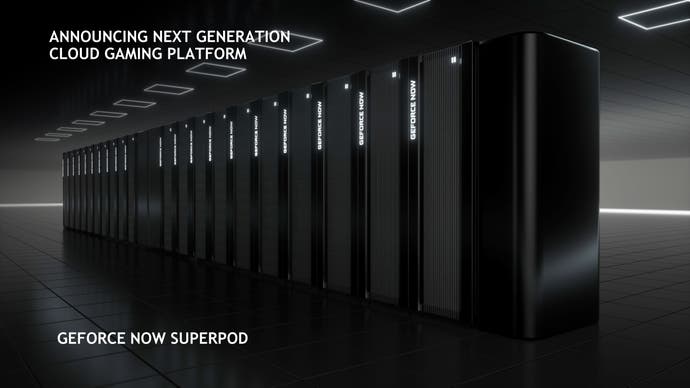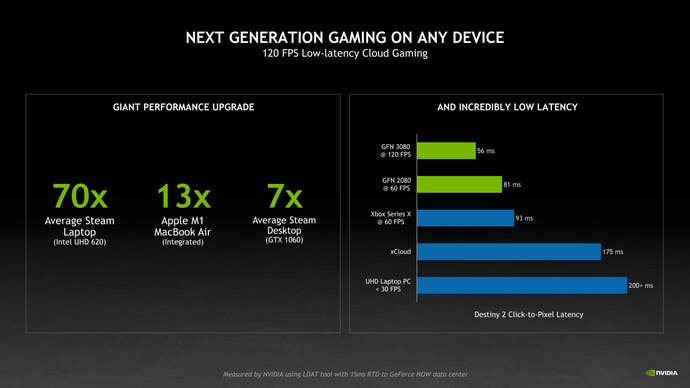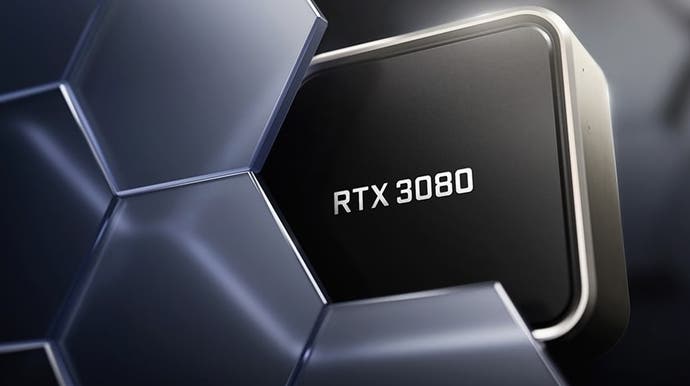Nvidia reveals RTX 3080-class GeForce Now premium tier
Bold claims are made for new low-latency technology.
Nvidia has announced a raft of upgrades for its GeForce Now cloud streaming service with a new premium tier offering RTX 3080 class graphics performance, allowing for 1440p120 gameplay across a range of platforms and 4K60 HDR, limited for now to Shield Android TV devices. New latency reductions techniques are also promised, with Nvidia making bold claims about input lag up against competing cloud technologies - and even local devices.
All of this is made possible via brand new class of server blade Nvidia is bringing online, dubbed the 'SuperPod'. While you're not getting to an actual RTX 3080 as such, you are getting equivalent enterprise-class hardware based on the same GA-102 silicon, backed up by an eight-core, 16 thread AMD Threadripper processor working in combination with ultra-fast PCIe Gen 4.0 solid-state storage and an impressive 28GB of 3200MHz DDR4 memory. This gives the SuperPod top-class graphics performance (only an RTX 3080 Ti or RTX 3090 are faster in the Nvidia stack), though CPU performance would fall a little short of the latest Ryzen 5000 and Intel CPUs.

The cost of this new premium tier is £89.99 for six months (UPDATE: 99.99 Euro and $99.99 US) - an interesting proposition for the kind of hardware that Nvidia reckons would cost you circa $2000 to buy, and that's without adjusting for the manic price inflation in the current market. Obviously though, you are renting access to Nvidia servers, so there's no hardware for to resell when it comes to upgrading, while the quality of the experience will come to down to the perennial cloud favourites - image quality and latency. In terms of the kind of connection you'll need to push this service to its limits, 35Mbps is cited for 1440p gaming a 120fps, while 40Mbps is required for 4K60 HDR cloud streaming.
It's Nvidia claims for latency that are intriguing. A new technology known as Adaptive Sync aims to cut down lag by more closely synchronising the cloud server with the refresh of your display, by rooting out dropped and duplicated frames. This works best for 120Hz panels, where claims for total end-to-end latency of less than 60ms have been mooted - in the same ballpark as the kind of latency observed on 60fps console games. Interestingly, Nvidia reckons playing Destiny 2 on GeForce Now even at 60fps (on a 120Hz screen? this isn' clear) offers a 12ms latency advantage over the same game played natively on Xbox Series X (81ms vs 93ms). Up against xCloud, Nvidia claims a phenomenal 94ms advantage for its 60fps stream compared to Microsoft's - a situation that obviously demands testing across a range of titles.

Adaptive sync is not limited to the premium tier and should roll out to all GeForce Now users. There's a basic free tier with one hour session lengths on what is described as a 'basic rig', while an RTX option with six-hour session lengths targeting 1080p60 costs £44.99 for six months. The new RTX 3080 'Super Pod' £89.99 service ups that to eight-hour sessions without having to share those servers with any other tier, while also offering higher resolution and refresh rate support. It's worth remembering that GeForce Now is essentially a way to stream the PC games you already own via storefronts like Steam and the Epic Games Store - though actual availability depends on whether they are available on the Nvidia's service or not.
This announcement is intriguing. Offering cloud-based access to state-of-the-art PC hardware is a good thing, though the current limitation of only offering 4K60 streaming via Shield Android TV is a little off-putting. Regardless, if Nvidia's claims hold up, we should be looking at a system with significantly more horsepower than current-gen consoles and competing cloud platforms, along with lower latency too. Pre-orders are available now, but we'll be taking a look at whether the service holds up as soon as we can.

